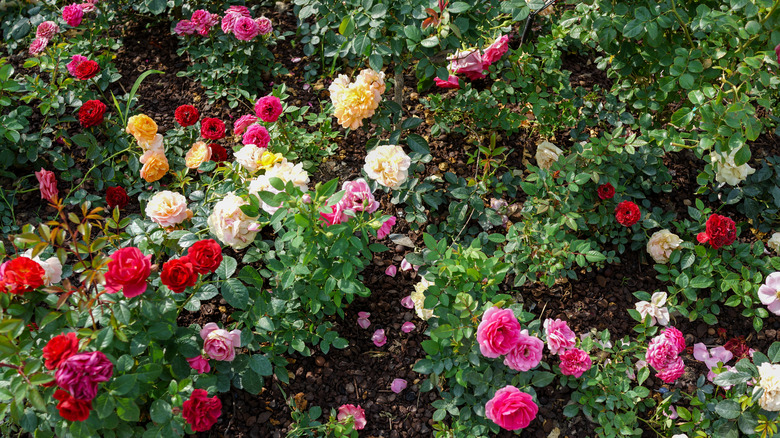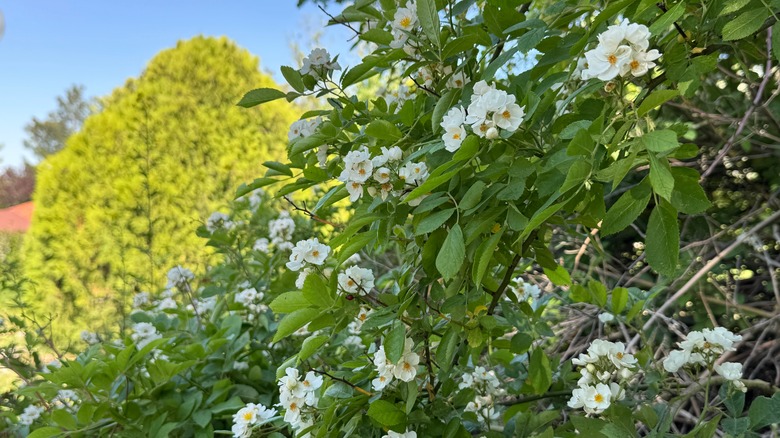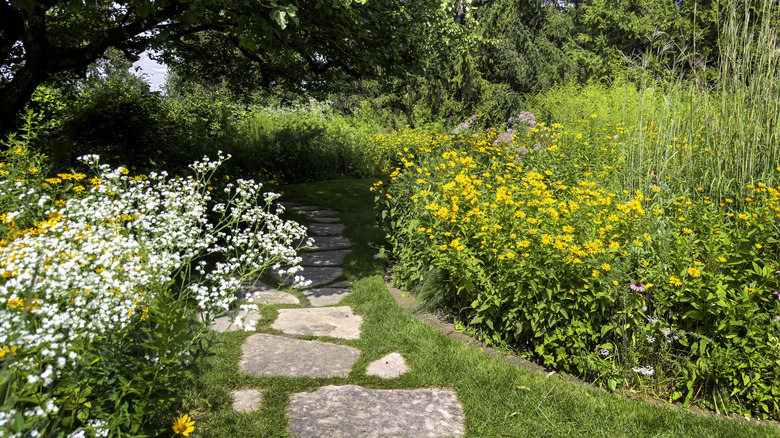The Invasive Garden Threat That Disguises Itself As A Harmless Rose
Colorful, fragrant roses bring timeless beauty to your yard and offer stunning accents for your home. Centuries-old rose breeds and modern rose varieties are popular with gardeners of all stripes. However, one well-known rose variety isn't welcome in anyone's garden — or anywhere else in the United States. The notorious multiflora rose (Rosa multiflora) is classified as an invasive species, imported into the U.S. during the late 18th century. Aggressively spreading multiflora roses take over diverse habitats, making it tougher for native plants to survive there. And not surprisingly, the multiflora rose will seize every square foot of garden available — often taking existing plants' sunlight and nutrients.
Imported as an ornamental, multiflora roses sport lovely pink or white cascading blooms. The thorny plants typically form thickets, attracting wildlife seeking food and protection. And as you might expect, 6-to-10-foot multiflora rose plants often overwhelm nearby vegetation. A new plant can pop up when its cane tips sprout roots from ground contact. Even worse, multiflora roses spread when birds consume the fruits and excrete the seeds during flight. If this marauder takes up residence in your garden, the invasive multiflora rose masquerades as a lovely flower.
Multiflora rose plants initially seemed ideal for livestock barriers, snow fences, and erosion management systems. However, these invasive plants soon began impacting entire ecosystems, and they thrive in almost any growth environment. A gardener's worst nightmare, this fast-spreading plant is listed in the Invasive Plant Atlas of the United States.
Navigating multiflora rose challenges
Getting rid of those pesky multiflora rose plants is like attempting to eradicate a colony of termites from your house. You may eliminate the destructive insects in one spot, but they quickly pop up somewhere else. Multiflora roses are particularly detrimental to livestock farms, where the invasive vegetation often takes over prime grazing territory.
Fortunately, there are a few strategies that can help banish multiflora rose plants from the landscape. First, frequent mowing or bulldozing can knock each plant down to a manageable size. Next, yanking the plant from the soil, followed by removal of shoot bud-containing roots, is a viable proposition.
For pastures and larger residential properties, a few industrious sheep or goats could provide a viable solution. While sheep will happily munch on leaves and fresh growth, goats are voracious eaters who aren't especially picky. They will methodically destroy every part of a multiflora rose plant they can reach. If you don't have your own goats, there are places where you can rent a goat for "goatscaping."
Rebalancing the ecosystem with native plants
Let's say you manage to eliminate multiflora rose plants from your garden or landscape. If you're left with a gaping hole (or a few), consider introducing native plants to your property. Because natives have learned to manage your region's temperature extremes and rainfall patterns, they typically bounce back from challenging weather conditions. As a bonus, native plants' deep roots can help control erosion on hills or in runoff-prone areas.
If you're concerned about disappearing wildlife habitats, native plants can be part of the solution. Native plants are wildlife attractors that provide birds, butterflies, and other beneficial creatures with food and predator cover. Some native roses are real bird magnets. Even better, native plants won't need often-pricey fertilizer.
So, how can you find native plants that will likely thrive in your garden and landscape? Searching state or regional native plant databases is a good first step. Your county's cooperative extension service can also provide guidance on native plant selection. Once your new plantings are in place, your battle with multiflora roses will hopefully be just a footnote in your gardening journey.


